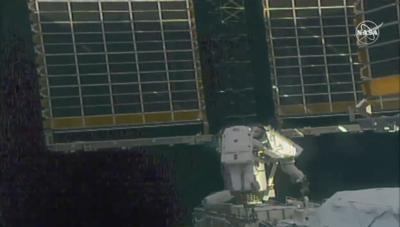Sat, Jun 19, 2021
Astro's Still Need To Install Electrical Cables And Drive The Final Two Bolts To Enable The Solar Array To Unfurl
NASA astronaut Shane Kimbrough and ESA (European Space Agency) astronaut Thomas Pesquet concluded their spacewalk at 3:26 p.m. EDT, Wednesday, after 7 hours and 15 minutes. In the seventh spacewalk of the year outside the International Space Station, the two astronauts installed a new ISS Roll-Out Solar Array (iROSA) into its mounting bracket on the far end of the left (port) side of the station’s backbone truss structure (P6).

Kimbrough and Pesquet successfully removed the array from its position in the flight support equipment and maneuvered it into position on the mast canister at the 2B power channel.
Before the new array can be deployed and begin providing power to the orbiting laboratory, spacewalkers will need to install the electrical cables and drive the final two bolts to enable the solar array to unfurl its fully deployed position. Pesquet and Kimbrough are scheduled for another spacewalk coming up on Sunday, June 20 to continue the installation of new solar arrays.
NASA is augmenting six of the eight existing power channels of the space station with new solar arrays to ensure a sufficient power supply is maintained for NASA’s exploration technology demonstrations for Artemis and beyond as well as utilization and commercialization.
This was the seventh spacewalk for Kimbrough, the third for Pesquet, and the third they conducted together. Kimbrough has now spent a total of 46 hours and 15 minutes spacewalking, and Pesquet’s total spacewalking time is 19 hours and 47 minutes.
Space station crew members have conducted 239 spacewalks in support of assembly and maintenance of the orbiting laboratory. Spacewalkers have now spent a total of 62 days, 18 hours, and 28 minutes working outside the station.
In November 2020, the International Space Station surpassed its 20-year milestone of continuous human presence, providing opportunities for unique research and technological demonstrations that help prepare for long-duration missions to the Moon and Mars and also improve life on Earth. In that time, 244 people from 19 countries have visited the orbiting laboratory that has hosted nearly 3,000 research investigations from researchers in 108 countries and areas.
More News
“We respectfully call on the City of Mesa to: 1. Withdraw the landing fee proposal immediately 2. Engage with the aviation community before making decisions that impact safet>[...]
High Speed Taxiway A long radius taxiway designed and provided with lighting or marking to define the path of aircraft, traveling at high speed (up to 60 knots), from the runway ce>[...]
Aero Linx: International Federation of Airworthiness (IFA) IFA uniquely combines together all those with responsibility for policies, principles and practices concerned with the co>[...]
Controller’s Expectation That VW02 Would Have Departed Sooner Led To An Inadequate Scan And Loss Of Situational Awareness Analysis: A Robinson R-44 helicopter N744AF, VW02 (V>[...]
A Few Questions AND Answers To Help You Get MORE Out of ANN! 1) I forgot my password. How do I find it? 1) Easy... click here and give us your e-mail address--we'll send it to you >[...]
 Aero-News: Quote of the Day (12.09.25)
Aero-News: Quote of the Day (12.09.25) ANN's Daily Aero-Term (12.09.25): High Speed Taxiway
ANN's Daily Aero-Term (12.09.25): High Speed Taxiway ANN's Daily Aero-Linx (12.09.25)
ANN's Daily Aero-Linx (12.09.25) NTSB Final Report: Diamond Aircraft Ind Inc DA20C1 (A1); Robinson Helicopter R44
NTSB Final Report: Diamond Aircraft Ind Inc DA20C1 (A1); Robinson Helicopter R44 ANN FAQ: Q&A 101
ANN FAQ: Q&A 101



